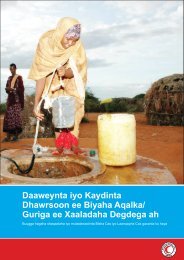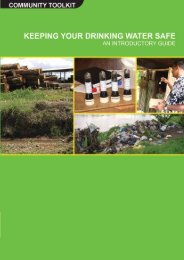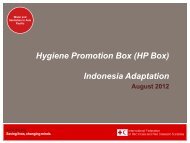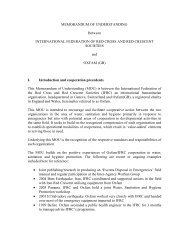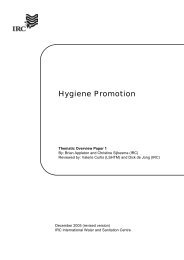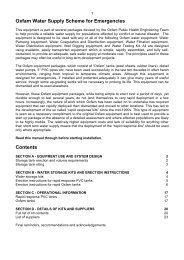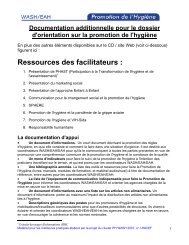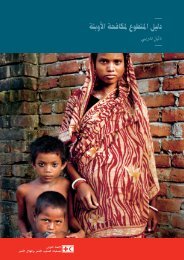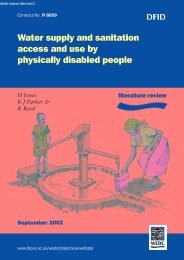Hitosa water supply: a people's project - watsanmissionassistant
Hitosa water supply: a people's project - watsanmissionassistant
Hitosa water supply: a people's project - watsanmissionassistant
You also want an ePaper? Increase the reach of your titles
YUMPU automatically turns print PDFs into web optimized ePapers that Google loves.
<strong>Hitosa</strong> Water Supply:A people’s <strong>project</strong>A WaterAid reportwritten byTrish Silkin
HITOSA WATER SUPPLY: A PEOPLE’S PROJECTSUMMARYThis report demonstrates that communities can successfully manage large-scale gravity<strong>water</strong> <strong>supply</strong> schemes.In <strong>Hitosa</strong>, Ethiopia, 31 communities work together to operate and maintain 122 tapstands and140km of pipeline. Each community has two representatives on the Water Management Boardwhich manages the Water Administration Office, employing 74 staff. All ongoing costs of thescheme are met by the <strong>water</strong> tariff.<strong>Hitosa</strong> has elements in common with other successful community managed schemes:• A severe <strong>water</strong> problem and high community motivation• The solution is appropriate to the level of community resources available for operation,maintenance and management• A government policy environment enabling community managementThe <strong>project</strong> did not require a high level of advisory input from WaterAid because <strong>Hitosa</strong> hasthe advantages of:• Strong existing community institutions• A high level of community resources, both financial and human• Good urban–rural cooperation• Higher than average levels of education• Well-trained and experienced government <strong>project</strong> staff‘There’s nothing peculiar about community management. It runs in the same way as anyother system, with the same rules and regulations. The difference is that decisions gettaken more quickly because we’re all on the spot and we’re as affected as anyone else bywhat happens to the <strong>water</strong> <strong>supply</strong>.’<strong>Hitosa</strong>’s Head of FinanceThis is the second in a series ofreports which analyse WaterAid’sexperience in supporting integrated<strong>water</strong>, sanitation and hygieneeducation <strong>project</strong>s in developingcountries.Cover photo: WaterAid/Jenny MatthewsWaterAidPrince Consort House27-29 Albert EmbankmentLondon SE1 7UBTelephone: 0171 793 4500Fax: 0171 793 4545Charity Reg No 288701Published by WaterAid,LondonApril 1998ISBN 0 9513466 3 6All rights reserved.PAGE 2
HITOSA WATER SUPPLY: A PEOPLE’S PROJECT<strong>Hitosa</strong> WaterSupply: Apeople’s<strong>project</strong>How a large-scale gravity<strong>water</strong> <strong>supply</strong> scheme inEthiopia is managed by thecommunities it serves.A WaterAid ReportWritten by Trish SilkinApril 1998PAGE 3
HITOSA WATER SUPPLY: A PEOPLE’S PROJECT<strong>Hitosa</strong> Water Supply:A people’s <strong>project</strong>How a large-scale gravity <strong>water</strong> <strong>supply</strong> scheme inEthiopia is managed by the communities it serves.ContentsIntroduction 7Why <strong>Hitosa</strong> has a <strong>water</strong> problem 8<strong>Hitosa</strong>’s Water Scheme today 14The challenges that lie ahead 22The lessons learned from <strong>Hitosa</strong> 24Boxes and Tables:About <strong>Hitosa</strong> 8Basic facts about <strong>Hitosa</strong> Water Supply Scheme 9Yearly activity <strong>Hitosa</strong> Water Supply Scheme 10Financing of <strong>Hitosa</strong> Water Supply Scheme 12Water Supply Scheme structure diagram 14Abebe and Yilma 15Workinesh Guda 16<strong>Hitosa</strong> Water Supply Scheme: income and expenditure 20<strong>Hitosa</strong>’s education in national perspective 25PAGE 5
HITOSA WATER SUPPLY: A PEOPLE’S PROJECTIntroduction<strong>Hitosa</strong> has never experienced thefamine or drought that seem to bepermanently, if undeservedly,associated with the name of Ethiopia. Indeed,the fertile soil and high rainfall that <strong>Hitosa</strong>enjoys have made it one of the most productiveand wealthiest weredas (districts) in thecountry, regularly producing bumper harveststhat help to feed less well-endowed areas. Untilrecently, however, the vagaries of geographymeant that <strong>Hitosa</strong> also suffered such an acuteshortage of drinking <strong>water</strong> that some peoplehad to walk up to 50km to fetch it.Since 1996, more than 60,000 people livingin 31 communities in <strong>Hitosa</strong> have beenprovided with <strong>water</strong> through a gravity <strong>water</strong><strong>supply</strong> scheme that is the largest in Ethiopia.Water runs from two springs, through 140kmof pipeline to 122 distribution points andmore than 300 individual buildings.The <strong>Hitosa</strong> scheme demonstrates theimportance of partnership. In thisundertaking, government, WaterAid andcommunities all had a role to play, and thescheme could not have succeeded withoutthe contribution of all three. Governmentwas responsible for designing andconstructing the scheme, WaterAid providedthe bulk of the capital investment, andcommunities contributed cash and labouramounting to almost 20 per cent of theconstruction costs.<strong>Hitosa</strong> also proves that large-scale does notnecessarily mean complex. Gravity <strong>water</strong><strong>supply</strong> schemes are simple to run and <strong>Hitosa</strong>is now fully under the management of a localWater Management Board made up ofrepresentatives of every communityconnected to the <strong>water</strong> <strong>supply</strong>. The Boardsupervises staff employed to operate theservice. The <strong>water</strong> tariff and charges paidfor private connections and repairs cover allthe running costs of the service.This case study does not seek to suggest thatthe <strong>Hitosa</strong> <strong>water</strong> service is universallyreplicable. <strong>Hitosa</strong> has some unusual features– in particular, it has a long history of socialand economic investment, and levels ofincome and education are higher than thenorm for rural Ethiopia. But <strong>Hitosa</strong> doeschallenge the convention that ‘communitymanagement’ in the Third World always meanssmall-scale and shows that people withoutspecialised skills, but with the necessarymotivation and training, can run a large-scaleservice efficiently and effectively.PAGE 7
HITOSA WATER SUPPLY: A PEOPLE’S PROJECTWhy <strong>Hitosa</strong> has a <strong>water</strong> problemABOUT HITOSA<strong>Hitosa</strong> is one of 20 weredas or districts in Arssi zone and one of 180 weredasin Oromiya region, one of nine regions forming the federal state.Oromiya is Ethiopia’s largest region at 350,000km 2 and its most populousat 18.7 million. Ninety per cent of the population lives in rural areas. Withan Infant Mortality Rate of 118/1,000 live births, Oromiya lies sixth equalout of 12 regions and metropolitan centres; it lies fourth in terms of lifeexpectancy at 49.2 years.<strong>Hitosa</strong> has an area of 937km 2 and a total population of 174,630. Iteya(<strong>Hitosa</strong>’s main town) lies on a tarmac road about 160km south-east ofthe federal capital, Addis Ababa, and 20km north-east of Asella, the capitalof Arssi.The population of <strong>Hitosa</strong> are all Oromo-speakers and are divided about 50:50between Muslims and Orthodox Christians. They are predominantly cropproducers who also own livestock.Arssi is among the first surplus-producing zones in Ethiopia, and <strong>Hitosa</strong> isone of its most productive weredas. <strong>Hitosa</strong> has never experienced harvestfailure, even in years of national food deficit.Literacy in <strong>Hitosa</strong> at 37 per cent is above the national average of 33 per centand the numbers of secondary school students in <strong>Hitosa</strong> is similarly high.SUDAN➛NKENYA0 250 500 Miles0 400 800 KmERITREAE T H I O P I ARed SeaDJIBOUTIAddis Ababa<strong>Hitosa</strong>SOMALIAIn 1992, when WaterAid agreed to assistpeople living in <strong>Hitosa</strong> wereda to build a<strong>water</strong> system that they could runthemselves, they found a community readyand willing to respond to the challenge. Theroots of their enthusiasm lay in six decadesof <strong>water</strong> rationing. ‘We even had to rationour children’s drinking <strong>water</strong>’ they said,‘and to bury our dead without washingtheir bodies.’<strong>Hitosa</strong>’s <strong>water</strong> problem dates from the 1930swhen an Italian entrepreneur and an Ethiopianlandowner went into partnership to exploit thefarming potential of the area. Because thesebusiness partners needed workers for theirventure, they moved people from where theywere living near rivers and springs and settledthem on lower, more fertile land.Though this part of <strong>Hitosa</strong> receives goodrains for farming, the main rivers that are itssource of drinking and washing <strong>water</strong> flowaround the district, rather than through it.Women now had to walk for several hours tofetch <strong>water</strong>. Some, especially those living inthe lowest lying areas, had to go so far thatthey could collect <strong>water</strong> only every few days.The centre of the newly-settled area becamethe town of Iteya, the wereda capital. As Iteyagrew, people tried to find a modern solutionto their problem. In the 1960s, a tanker usedto come 50km from the Awash River to sell<strong>water</strong> to the town. This gave some of Iteya’sresidents the idea of clubbing together to buytheir own tanker. They managed to raise25,000 Birr and to buy a second-hand one.Unfortunately, this regularly broke down,repair bills provoked arguments about money,someone ran off with the funds and in theend it was scrapped.In the 1960s, the Swedish InternationalDevelopment Agency (SIDA) started tofinance rural development in Arssi, the zonewhere <strong>Hitosa</strong> is situated, through a unit inthe Ministry of Agriculture known as ARDU(the Arssi Rural Development Unit). Duringthe 1970s, ARDU drilled to almost 300metres in <strong>Hitosa</strong> trying to locate <strong>water</strong>, butfailed to find it even at that depth.Around the same time, the local farmers’cooperative found it had surplus funds in itsaccount amounting to 40,000 Birr. Theysuggested to people in Iteya town that theyjointly contact ARDU and ask them to build apipeline from the Gonde River and to installpublic tapstands. With local funds of 55,000Birr, technical assistance and 100,000 Birrfrom ARDU, and additional financing fromSIDA, this was completed in 1979.ARDU trained local people to repair thesystem and in this way the scheme ranreasonably well for a few years. No one wastrained to manage the scheme, however, andafter SIDA pulled out it was a struggle forlocal people to run it themselves. They raisedmoney, but the technicians were poorly paid.One by one they left and gradually the pipelineand taps fell into disrepair.PAGE 8
HITOSA WATER SUPPLY: A PEOPLE’S PROJECTPeople stayed in the area because farmingwas good and in many respects they enjoyeda high standard of living. The single exceptionto this was the severe lack of <strong>water</strong>, whichwas also holding back Iteya’s prosperitycompared with that of neighbouring towns.By the 1990s, local people had almostdespaired of finding a real and permanentsolution to their problem.Finding a solution to the problemOne legacy of the SIDA-ARDU collaborationwas a cadre of well-trained and experiencedgovernment staff in Arssi. They believed thatthe best solution to <strong>Hitosa</strong>’s <strong>water</strong> problemwas to take the <strong>water</strong> by gravity from twosprings in the mountains and to feed itthrough a network of pipes to Iteya and thesurrounding villages. The resulting schemewould be simple to construct, and cheap tomaintain and repair.The scheme would <strong>supply</strong> <strong>water</strong> to 56,000people living in 28 villages and three smalltowns through 140km of pipeline to 122 publictapstands as well as to individual buildings intowns. In 15 years time the population servedby the network was expected to reach 71,000.This would make the pipeline bigger than anyother similar scheme in Ethiopia.The scheme would also be expensive andwith investment costs of over £1 million itcould not be built without external financing.WaterAid’s Representative in Ethiopia wasknown to government staff through hisprevious work in Arssi, and the Departmentof Rural Infrastructure (ARDU’s successor)approached him to ask for help in fundingthe scheme. WaterAid was keen to assist,largely because the organisation had a highopinion of the competence of governmentstaff and officials in Arssi.Though the scheme was technically simple,the length of the pipeline and the number ofpeople, villages and towns to be served wouldmake it complex to manage. Government andWaterAid needed to make as much investmentin the ‘software’ of the scheme (theBASIC FACTS ABOUT HITOSA WATER SUPPLY SCHEMENo. of people served by the scheme 1993-2008 56,000 – 71,000Area in km 2 500Spring capping 4River crossings 19Pipeline in km: main pipeline 33Pipeline in km: distribution lines 109Pressure breaks 5Reservoir capacity/days <strong>supply</strong> 575m 3(1 x 100m 3 +1 x 50m 3 +17 x 25m 3 ) / 1-2 daysAccess roads in km 20management systems) as in the ‘hardware’(the pipe network and the tapstands).Despite this potential complexity, all theparties involved opted for management bythe community rather than by government.They had an example of a similar efficientlymanaged <strong>water</strong> service in the next-doorwereda of Dodota. The Dodota scheme isalso a community managed large-scalegravity scheme, which has a high profile,and is primarily maintained and managedby local women.Involving the communityGiven the acute shortage of <strong>water</strong>, localpeople’s motivation to be involved in buildingthe proposed scheme was high.Nevertheless, they had suffered a series ofset backs in the past in trying to find asolution to the problem, and it was importantthat everyone understood exactly what thenew scheme would involve. In particular, theywould need to be equally motivated tomanage the service once it was in operation.Through experience, WaterAid has identifiedfour conditions that need to be met forcommunities to manage <strong>water</strong> <strong>supply</strong>schemes successfully. The first of these isthat lack of <strong>water</strong> should be a severeproblem, to which the proposed technicalsolution offers the best or the only answer.PAGE 9
HITOSA WATER SUPPLY: A PEOPLE’S PROJECTAs we have seen, shortage of <strong>water</strong> had beenan acute problem of long- standing in <strong>Hitosa</strong>and other solutions had been tried and failed.The other three conditions are that:• users must be involved from the outsetof the <strong>project</strong>, through every stage andup to evaluation of the finished <strong>project</strong>• there must be an organisation of usersto run the completed scheme with localpeople being trained in management, aswell as in maintenance and repair• this local organisation cannot survive inisolation but must be linked to a widernetwork of government or nongovernmentservicesThanks to the mutual respect and trustexisting between WaterAid and governmentstaff, WaterAid was able to encouragegovernment to adopt an approach that wouldput these conditions in place.which also enabled government to take theleading role in this <strong>project</strong>.To execute the <strong>project</strong>, the governmentestablished a Project Coordination Office withstaff assigned to <strong>Hitosa</strong> from the Zonal NaturalResources, Agriculture and HealthDepartments. As a body outside normalgovernment structures, the ProjectCoordination Office enjoyed a higher level ofindependence in day-to-day decision makingthan is normal in government service. TheOffice’s direct access to the resources providedby WaterAid further enhanced its autonomy.This enabled the work to proceed morerapidly than would otherwise have been thecase. Progress was maintained despite majorrestructuring of government institutionsmidway through the <strong>project</strong> when at least oneof the government units involveddisappeared. In fact, despite thesedisruptions, the <strong>project</strong> was accomplishedwithin budget and ahead of time.Government takes the leadGood relations between government, thepeople of <strong>Hitosa</strong> and WaterAid were a particularstrength of the <strong>project</strong>. They were based largelyon the success of much of ARDU’s earlier workEffective collaborationThe good informal relations existing betweengovernment, communities and WaterAidencouraged effective collaboration betweenthem and allowed each to fulfil its role1 The Ethiopian financial year runsfrom 1 July to 30 June. Between1993 and 1997 the rate of exchangechanged from £1 = 7.5 Birr to £1 =10 Birr.2 In the six months to January 1998the number of private connectionshad risen by a further 79 to 3303 1 November 1994 – 30 June 1995YEARLY ACTIVITY HITOSA WATER SUPPLY SCHEME JULY 1993-JUNE 1997 1Activity 1993-4 1994-5 1995-6 1996-7 TotalCommunity funds forcapital costs (Birr) 132,100 128,600 108,400 53,600 422,700Community labour(person days) 4,481 21,925 17,304 6,343 50,054of <strong>water</strong> points built - 21 93 8 122of villages connected - 7 18 3 28of towns connected - 3 - - 3of private connections - 28 127 96 251 2people trained 90 50 50 - 190new employees - 15 40 19 74Price of <strong>water</strong> (1m 3 ) - 75c 75c 1 Birr 1 BirrAnnual income (Birr) - 33,500 3 115,300 154,100 302,900Annual expenditure (Birr) - 7,600 3 74,800 131,300 213,700PAGE 10
HITOSA WATER SUPPLY: A PEOPLE’S PROJECTproductively. Formal coordination wasorganised through a Zonal SteeringCommittee with members from thegovernment Zonal Departments representedin the Project Coordination Office and fromthe community, and with WaterAid’sRepresentative in attendance.This committee was the highest decisionmaking body of the <strong>project</strong> and managed theProject Coordination Office. The committeemet quarterly to review progress, to solveproblems, and to make plans for the comingquarter. Annually, it reviewed the budget andplan for the past year and approved budgetsand plans for the coming year. Below theZonal Steering Committee there were Weredaand Kebele Committees so that a structureof coordination and a line of communicationexisted from the highest to the lowest levelsof the <strong>project</strong>.Organising the communityWork on the scheme began in 1993, andthe first stage was for <strong>project</strong> staff to gofrom Kebele to Kebele convening meetingsand explaining how the scheme would work.Once people were clear what would beinvolved and their commitment had beensecured, local committees were formed toorganise their participation.The Kebeles provided the structure throughwhich this could be done. First, each Kebelechose seven people to serve on a KebeleWater Committee. These people wereresponsible for collecting a 45 Birrcontribution from each household, for makingsure that every household in the Kebelecontributed some days of labour to the<strong>project</strong>, and for protecting <strong>project</strong> property,equipment and staff when construction wasunder way in the Kebele.Kebeles were free to choose the seven peoplewho they thought would be most suitable toserve on the Committee, but within an agreedformula. WaterAid insisted that of the seven,four must be women because women bearthe primary responsibility for collecting, storingand using <strong>water</strong>. It went against local traditionsfor women’s informal responsibilities to betransformed in this way into formal publicduties and some Kebeles resisted theproposal, but every Kebele finally agreed.Women turned out to be among the mostactive participants in the <strong>project</strong>, both in termsof contributing cash and in providing labour.From among their number Kebele WaterCommittees appointed a Chairman,Secretary and Treasurer. Despite their titles,these people were not all literate, their mainqualifications being that they wererespected, responsible and active membersof the community. If the Committee neededto read a document or send a letter, aliterate neighbour or relative was availableto help them.The Kebele Water Committees werereplicated at district level by a Wereda WaterCommittee composed of an equal numberof men and women representatives from theKebeles. The Wereda Water Committee metquarterly to plan and to review progress incontributing finance and labour, and toencourage or pressurise Kebeles that werefalling behind in their commitments.Members of the Wereda Water Committeerepresented the community on the ZonalSteering Committee, and these people hadto be literate and numerate.Participating in the workGiven the topography of the land and thelength of the pipe network, technicalconsiderations determined which Kebeleswould be connected to the pipeline. There waslittle scope, therefore, for local involvementin the overall design of the scheme.Within each Kebele, however, local peoplewere involved in choosing the preferredlocation for the tapstands which the <strong>project</strong>aimed to build no more than 250 metresaway from people’s homes. When thescheme was still at the design stage, peoplewere living in centralised villages to whichthey had been moved under the previousPAGE 11
HITOSA WATER SUPPLY: A PEOPLE’S PROJECTgovernment’s villagisation programme and,given this, tapstands were planned to be incentral locations. With villagisation a thingof the past, however, people started to moveback to their original, more dispersed,homesteads while construction was going on.This meant that many of them now livedfurther away from the tapstand and during anevaluation of the scheme carried out byWaterAid in 1996, the distance they now hadto walk provoked considerable criticism. Someresidents complained that they had neverbeen consulted as to where the tapstandsshould be and the evaluators concluded thatthe Project Coordination Office could havebeen more flexible in responding to the changein circumstances. Two years on, thecontention appeared to have abated – the<strong>water</strong> was, after all, still much closer to homethan it had ever been before.Building the entire pipe network took threeyears during which time the Kebele WaterCommittees contributed around 450,000 Birrand around 50,000 days of labour. The lattermainly involved excavating the trenches,laying pipes and back-filling the trenches afterthe pipes were laid. Local people were alsoresponsible for gathering local materials suchas sand and gravel, and transporting themto the construction sites. Funds and labourtogether amounted to around 17 per cent ofthe original budget.This type of community contribution for localdevelopment activity is a well establishedtradition in many parts of Ethiopia. <strong>Hitosa</strong>stood out, however, for the extent to whicheveryone was willing to work, especiallyFINANCING OF HITOSA WATER SUPPLY SCHEMECosts and cost sharing (1993-1996)Birr £ Sterling Per centCommunity Cash 465,138 140,951 13Labour 155,045 46,983 4Government Staff 136,661 41,715 4WaterAid Cash 654,564 79TOTAL 1,084,213 100women, even during difficult times such asthe fasting season of Ramadan, or in the mainagricultural season (June to October) when theneed to bring in the harvest normally bringsall other activity to a halt. This was clearevidence not only of people’s urgent need for<strong>water</strong> but also of their confidence that thescheme that they were building would finallybring a solution to their problem.TrainingAll those working on the <strong>project</strong> had learnedfrom the experience of the earlier piped <strong>water</strong>scheme that it was not enough simply to givelocal people technical training to repair thepipeline and taps, they also needed to betrained to manage the entire <strong>water</strong> <strong>supply</strong>service. Moreover, a properly establishedoffice with full-time staff would be neededto operate and maintain a scheme as largeas <strong>Hitosa</strong>.The <strong>project</strong> adopted an original approach totraining and recruitment for the service. Theystarted by inviting Kebeles to put forwardyoung people for training while the schemewas being constructed. As with the WaterCommittees, women were particularlyencouraged to come forward for training.Trainees were expected to have at least fiveyears of schooling except in those Kebeleswhere few girls went to school, where thiscriterion was waived in favour of basicliteracy. Since the more senior posts in theservice would require considerably higherlevels of education, some trainees weresenior secondary school graduates.In all, 190 young people were trained duringthe three years of construction, of whom wellover half were women. The course consistedof a month’s theoretical training in the maincomponents of the work: technical,administration, finance, health education andsanitation. This was followed by a three tofour month apprenticeship where traineesworked on the scheme and were paid at thesame rate as other daily labourers. Selectionfor posts was based on performance duringboth the theoretical training and thePAGE 12
HITOSA WATER SUPPLY: A PEOPLE’S PROJECTapprenticeship. From the 190 trainees, 74were chosen for employment, of whom 63were women.Shortly after assuming his post, the Head ofthe Water Administration Office was sent tothe Arba Minch Water Technology Institute insouthern Ethiopia for three months trainingin all aspects of community management of<strong>water</strong> <strong>supply</strong> schemes.WaterAid/Jenny MatthewsSugi Mohamed is 14-years-old and is happy to participate with other members of hercommunity in digging trenches for pipes to carry safe <strong>water</strong> to tapstands in her village. ‘I haveno problem doing such hard work,’ she says.PAGE 13
HITOSA WATER SUPPLY: A PEOPLE’S PROJECT<strong>Hitosa</strong>’s Water Scheme todayIn November 1994, the <strong>Hitosa</strong> WaterSupply Scheme began its operations. Itwas managed by a Water ManagementBoard of Kebele Water Committeerepresentatives and operated by a WaterAdministration Office staffed by graduatesfrom the training courses. Althoughconstruction was not completed until 1996,the service was formally inaugurated by thePresident of the Oromiya Regional Councilin April 1995 when all three towns and sevenof the villages were connected to the <strong>supply</strong>.HITOSA WATER SUPPLY SCHEME STRUCTUREThe Water Administration OfficeThe Water Administration Office is theoperational heart of the service. It isresponsible for its day-to-day running, forall repairs and maintenance to the pipelineand tapstands, and for connecting newprivate customers to the <strong>supply</strong>. It operatesout of small offices housed in a compoundin Iteya provided by the Kebele. The serviceowns a pick-up and two motor-bikes whichwere given to the Office by WaterAid whenconstruction was completed, as well asanother pick-up and a lorry currently on loanto a different <strong>project</strong>.WaterAidLines of authorityLines of communicationFive communityrepresentativesExecutive CommitteeWater Management Board(31 women:31 men)Department of AgricultureDepartment of HealthIteya townWereda AdministrationPrivateCustomersWater Administration OfficeKebele WaterCommitteesKebeleAdministrationPublicCustomersOf the 74 staff employed in the WaterAdministration Office, 13 are based in Iteya,divided between Administration, Finance andTechnical Units. All 13 have between eightand 12 years of schooling but, apart fromtwo who have also done some short-termvocational training, none has had any trainingother than that provided under the <strong>project</strong>.The immediately most striking quality ofthese staff is their youth. The oldestemployee is 32, their average age is 25, andfor most this is their first job. These areliterally <strong>Hitosa</strong>’s children.The Head of the Water Administration Officeis also Head of the Administration Unit.Reporting directly to him are the storesmanager,a driver and three guards.Immediately under the Head of Finance area cashier and a <strong>water</strong> meter reader. TheTechnical Unit has four technicians – the UnitHead and three othersTechnicalUnit (4)AdministrationUnit (6)FinanceUnit (64)Tap attendantsHead ofTechniciansHead of WADStoresManagerDriverGuardsHead of Finance Unit/AccountantsCashierWater Meter ReaderTap attendantsThe remaining 61 staff are tap attendants,all of them women, who are formally withinthe Finance Unit. They live close to thetapstands for which they are responsibleand they are the public’s first point ofcontact with the service. The tapstands areopened in turn, some operating in thePAGE 14
HITOSA WATER SUPPLY: A PEOPLE’S PROJECTmornings from around seven to 12 and theothers in the afternoons from one or twountil five or six.It was not easy to recruit women to be tapattendants in a society where people areconservative about matters of gender.Villagers were reluctant to put forward womenfor training and employment. If a job wasgoing in the village, they argued, it ought togo to a man, the head of the household.Project staff countered that woman bore thebrunt of <strong>water</strong> collecting, and wereresponsible for making sure that it wasproperly stored and used. Eventually everyKebele put women forward as trainees.Most of the women are young and marriedwith children. Only a handful have beenemployed before. They are paid 105 Birr amonth, equivalent to the national minimumwage. Initially, they took 60 per cent of thetakings from the <strong>water</strong> sales, but this meantthat their income varied from month to monthand they preferred to have something steadyand reliable. The present system means thatsome tap attendants have to be temporarilylaid off each year during the rainy seasonwhen <strong>water</strong> sales go down.Water is sold for 1 Birr for 1m 3 which at thetapstand translates into five cents for 40litres. Most people collect <strong>water</strong> in 20 litreclay pots or jerrycans. Tap attendants alsohave books containing five cent vouchers sothat the many customers who want to takeonly 20 litres at a time can buy a voucherwhich they keep and present when they returnto take the second 20 litres. Similarly, acustomer who wants to buy a large quantityof <strong>water</strong> – for example, for a wedding – andwho needs to make several trips to thetapstand, can buy several vouchers at once.Each book, worth 50 Birr, contains 1,000vouchers.Every month the tap attendants deposit theirtakings and their empty voucher books withthe Water Administration Office, and collecttheir salaries and new voucher books. Everytapstand has a meter which is checked monthlyby the Office <strong>water</strong> meter reader and this actsas a check against the sales reported andthe monies deposited by the tap attendant.Tap attendants are allowed wastage of fourper cent so that customers can wash out theircontainers before filling them.Kebele Water CommitteesThe Water Committees selected at the startof the <strong>project</strong> are still in place, and memberswill continue to serve as long as they areable to work, and people are satisfied withthe job that they are doing.ABEBE AND YILMAAbebe Negusse and Yilma Kebede are young men of 25 and 31, fromIteya and Hidibiro village respectively. Both are 12th grade graduates.Abebe’s father is a tailor and Yilma’s a farmer. Yilma himself ownsland and farms in his home village.The two of them are also the mainstays of the Water Administration Office,Abebe being the overall Head and Yilma the Finance Head. Both were veryfamiliar with <strong>Hitosa</strong>’s <strong>water</strong> problems having spent much of their childhoodfetching <strong>water</strong> from distant rivers.Abebe first learned that things might change for the better in 1992 whenhe was in 11th grade and was asked to be part of a welcoming ceremonyfor a British visitor from WaterAid. He liked the things she said but wassceptical about whether anything would really change. While he was in12th grade, however, the start of the <strong>project</strong> was announced.During this first year more visitors arrived from WaterAid, this time a groupof British schoolchildren who were visiting the <strong>project</strong> as a way of learningabout Ethiopia and its <strong>water</strong> problems. Abebe was impressed – if Britishpeople were this concerned about <strong>Hitosa</strong>’s <strong>water</strong> problems, then perhapshe should be too. So, instead of applying to be a teacher or agriculturalextension worker which is what he had had in mind, he applied to work onand to be trained by the <strong>project</strong>. He found he enjoyed it and he passed outfirst of the 190 trainees. In 1994, he was appointed Head of the WaterAdministration Office.Yilma already knew he wanted to use his mathematical skills in a way thatwould be useful to his community. He had worked for six years as theaccountant for a local farmers’ cooperative and he saw the new <strong>project</strong> asa way of continuing to give service while also developing his own career.His enthusiasm for being involved in a scheme that solved <strong>Hitosa</strong>’s <strong>water</strong>problems was heightened when he saw how rudely commercial <strong>water</strong> sellerstreated their customers who were desperate for <strong>water</strong>. Yilma came secondin the training and was duly appointed Head of Finance.Yilma likes his present job. ‘First, I’m providing my own people with a service.But I get a lot of job satisfaction in other ways – I like accountancy, andthis is a good opportunity to use my skills, and moving to the WaterAdministration Office represents another stage in my career.’PAGE 15
HITOSA WATER SUPPLY: A PEOPLE’S PROJECTWORKINESH GUDAWorkinesh Guda is 20-years-old and lives in Hatetulu village. Shewas selected by her community to be a tapstand attendant andhas worked in the job for three years. She works from 8am to6pm, five days per week. ‘I have every Monday free – that is market day.People collect enough <strong>water</strong> on Sunday for two days because they are busyon Monday.’‘The community are very happy with the tapstands here,’ says Workinesh.‘Sometimes if there is a special feast or celebration they ask me to turnthe <strong>water</strong> on early, so I start work earlier. When the queues are short I sitin the shade and rest or do some sewing. I am happy with the work andthe training, and everything works well. I haven’t had to do any big repairsfor three years.’WaterAid/Jenny MatthewsWith the transition to an operational service,the role of Water Committees has changed.Now they supervise the tap attendants andattempt to resolve any problems that arisein their work. They are also responsible forensuring that the tapstands are not abusedand that they are working properly. Theyreport problems, damage or breakdowns tothe Water Administration Office.Under a programme of work starting in 1998,Water Committees will assume responsibilityfor health education and sanitation. Duringthe 1996 evaluation of <strong>Hitosa</strong>, the evaluatorsnoted that these activities were not wellintegrated with the <strong>water</strong> <strong>supply</strong> programme.They concluded that this was because <strong>water</strong>quantity was a far more urgent concern formost people than health education andsanitation which were given a low priority.The Water Management BoardThe Water Management Board is the highestdecision making body of the scheme andthe formal employer of the WaterAdministration Office. It is composed of 62members: two representatives from eachWater Committee, with equal numbers ofwomen and men. Although WaterAid haswithdrawn from active involvement in thescheme, WaterAid’s CommunityParticipation Specialist acts as an adviserto the Management Board.When it was first set up, the Board metmonthly so that every village and town couldbe directly involved in managing the service.This proved too unwieldy and it was alsodifficult for representatives from the moredistant villages to attend every month.Eventually, the Board decided to delegatesupervision of the Office to a nine-memberExecutive Committee, and it reconstituteditself as a general assembly.Today the Board has two main roles. The firstis to approve the annual budget and planpresented by the Heads of Administration andFinance. It does this in the last quarter ofthe financial year (April to June) and thenmeets quarterly to receive narrative andfinancial reports. The Board’s secondfunction is to provide relevant information tothe Executive Committee and WaterAdministration Office on problems andconditions in the villages and towns coveredby the service.The Executive CommitteeThis is composed of five Board membersand four local government officials (exofficiomembers) who are representativesfrom the wereda administration, Iteya towncouncil, and from the Departments ofHealth and Agriculture. The WaterDepartment is not represented because ithas no staff at wereda level.The Executive Committee defines its role asbeing ‘to ensure that the WaterAdministration Office is doing its job inPAGE 16
HITOSA WATER SUPPLY: A PEOPLE’S PROJECTguaranteeing <strong>water</strong> to everyone.’ TheCommittee meets formally once a month, butmembers are in regular contact with theOffice between meetings to bring to theirattention problems that need sorting out andto help them resolve difficulties. TheExecutive Committee approves all extrabudgetary expenditure, through the signatureof one of the ex-officio members, and reportsquarterly to the Board.Building responsibility for theserviceWith construction of the <strong>water</strong> <strong>supply</strong> schemecomplete and the Water Administration Officein operation there is a risk that communitieswill see their role as over. But if the WaterAdministration Office is to continue to give agood service, communities must feel acontinuing sense of responsibility for the<strong>water</strong> <strong>supply</strong>. They are most likely to developthis if they trust the service, and thisrequires the Water Administration Office tobe efficient and for the Water ManagementBoard to run its affairs in an accountableand transparent way.Efficiency and responsivenessCustomers’ first point of contact with theservice is through the tap attendants.Customers expect tap attendants to open thetapstands promptly, to be polite and helpful,to be willing to stay late if long queues meanthat not everyone has collected their <strong>water</strong>when it is time to close. They must also becompletely honest in handling money. So far,there have been few complaints and manycompliments on their performance.Similarly, customers expect the WaterAdministration Office to carry out repairsquickly and efficiently and this has been thecase to date. The Office is accessible to mostpeople, and it is easy for Committeemembers and even ordinary customers to gothere to report problems. The Technical Unitis often able to do repairs within a few hoursof being notified, thanks to a good reportingsystem and adequate spares, equipment andmeans of transport. It also helps that Officestaff know that when they go home at nightthey have to face their customers who arealso their neighbours, or even their mothersand fathers.Up to now, the Administration Office has beenjudged by its customers to be efficient andresponsive. But the Office and the Boardknow that they cannot afford to becomplacent and that their greatestchallenges lie ahead as the physicalstructures of the system age and as costsinevitably increase. For this reason, the nextphase of WaterAid support will see aconcerted effort in training staff andCommittee members in all aspects ofmanagement and financial planning.Accountability and transparencyWhen there was no <strong>water</strong>, every village andtown had an equal stake in constructing asystem that would solve this problem. Now,everyone needs to feel that they have anequal stake in the service and that noKebele is penalised by being further awayfrom the Office in Iteya. Some villages havesaid that they are worried about how far theyhave to go to reach the Office, but the Boardis in daily contact with all the users since ithas members in every Kebele. Everybodycovered by the service can check howdiligent their representatives are insupervising tap attendants, in reportingbreakdowns and in making sure that repairsare carried out quickly.The financial systems used by theAdministration Office are simple and opento scrutiny, starting from the methods ofpayment at the tapstand and up to the annualincome and expenditure account. Thepaperwork used by the Finance Unit is in goodorder, and some of it decorates the walls ofthe Finance Head’s office giving customersand others immediate visual information onthe numbers of users since the servicestarted, and on annual income andexpenditure in the same period.PAGE 17
HITOSA WATER SUPPLY: A PEOPLE’S PROJECTBoard members demonstrate a real grasp ofthe service’s activity and finances, andbudget approval and review is no mererubber-stamping. They refused approval ofthe first draft of the 1997-1998 budget, forinstance, because they felt that the estimatefor the expected number of new privateconnections was wrong. They noted that theestimate was based on the total for theprevious year and they asked the Office torevise it to take into account the rate ofgrowth in the number of private customerswho are increasing rapidly. Similarly, theynoted that <strong>project</strong>ed income from sales wasbased on an old tariff and they asked staffto revise it in line with a proposed increase.The service stands or falls by whether itscustomers believe that it is being run honestly.From direct observation, users know that nopersonal gain has accrued to being on theCommittee or Board. All Board members givetheir time free, and even pay from their ownpockets to attend Board meetings. It is a goodindicator of people’s motivation to make theservice work that so many are willing to do this.Where evidence of malpractice is found,customers need to know that the problem willbe dealt with promptly, efficiently and accordingto law. This has already been demonstratedwhen meter readings showed that over a periodof months one tap attendant had ‘borrowed’some 800 Birr. Oddly, in such cases Ethiopianlaw simply requires employees to repay thefunds, if necessary in instalments. Thisprocedure almost inevitably means that theoffender continues in employment, at least untilthe debt is paid off. This is what happened inthis case – though the miscreant has now‘retired’ from the service.Demonstrating responsibilityTwo good indicators of whether people feelresponsible for the service are that theyaccept the tariff and that they look after thenetwork and are willing to pay for repairs.Without this, the Administration Office willbe unable to maintain and repair the systemor keep it in good order.Accepting the tariffThe <strong>water</strong> tariff has sometimes beencontentious. At the start of the service <strong>water</strong>cost 75c for 1m 3 , a rate that peopleconsidered reasonable. After two years theBoard proposed to raise this to 1 Birr for1m 3 . Even though this was still lower thanthe government charge of 1.30 Birr, itevoked considerable resistance and alsosome muttering about money going intopeople’s pockets.Board members live in close proximity to theircustomers and they cannot get away withsimply issuing a formal notice of increase –they have to give a proper explanation as towhy the increase is necessary. In thisinstance, the Board’s main concern was toraise staff salaries which were low comparedwith equivalents in the public and privatesectors. The Head of Administration, forexample, received only 185 Birr a monthwhereas a new teacher earned 305 Birr, andagricultural incomes can go as high as 1,000Birr a month. The Board planned to raise hissalary to 250 Birr and the salaries of otherstaff by similar amounts.The Board put it like this: ‘These are yourchildren who are running the service. If youdon’t agree to pay the higher price, we won’tbe able to increase their salaries and thenthe service will collapse. Which would yourather do – pay them to work and provide youwith <strong>water</strong> or pay them to sit at home doingnothing? You have already worked so hard toget this <strong>water</strong>, why put that at risk now?’ Theproposed tariff increase went through.Looking after the networkThe physical structures of the <strong>water</strong> <strong>supply</strong>system are simple, consisting mainly of thepipeline network and of masonry tapstandson which the only moving parts are the tapsand gate valves. The most common breakagesare in the pipeline and the moving parts.Pipes are buried to protect them from theelements and from accidental damage, butPAGE 18
HITOSA WATER SUPPLY: A PEOPLE’S PROJECTWaterAid/Jenny MatthewsTrained technicians (picturedhere with members of the localcommunity) are quickly calledin to repair broken pipes, andthe <strong>water</strong> supplies are not cutoff for long.damage occurs because people deliberatelybreak them open to <strong>water</strong> animals – herdersare the usual culprits. Tapstands tend to getdamaged through negligence, mainly bycustomers handling the taps roughly or bychildren who play with the taps and gate valves.Most repair charges are levied on the wholecommunity where the damage occurs at cost.However, since damaged pipelines can cutoff the <strong>water</strong> <strong>supply</strong> not only to the nearestvillage but also to neighbouring ones thereis a standard 500 Birr charge for theserepairs – a high rate that is intended toencourage communities to guard the networkaround their village and to instil the idea thatthey have a responsibility for the network asa whole, not just for their part of it.The Water Management Board is certain thatpeople will look after the <strong>water</strong> system andthey contrast this with people’s attitudetowards government property. When theprevious government fell, many Ethiopiansexpressed their hatred of it by looting anddestroying government buildings. The presentgovernment is anxious to avoid anyrepetition: government members of theExecutive Committee put it this way: ‘Peopleneed to know that the system belongs tothem. If they think it belongs to thegovernment, they’ll simply neglect it or worse,they’ll destroy it.’Maintaining links with governmentAs a community managed scheme, <strong>Hitosa</strong> isnot seeking to circumvent government: thescheme was built by government and it isimportant that government officials continueto feel that they have a stake in its success.Despite major changes to the structures ofgovernment administration the scheme hasbeen able to maintain its links to government.One way of doing this is by operating withinsimilar parameters to those in use ingovernment run schemes. <strong>Hitosa</strong> operatesalong orthodox management lines, using thesame systems and procedures asgovernment run <strong>water</strong> <strong>supply</strong> services. Thetariff charged is only slightly less than thegovernment tariff, and the charges forconnections and repairs are set in relationto government rates.In addition, most of the AdministrationOffice’s financial record files, books andcards are provided by the Zonal WaterDepartment. Unfortunately, this did enablea staff member of the Water Departmentto obstruct the smooth running of theservice on one occasion by claiming thathe had no voucher books in stock. Voucherbooks were rapidly discovered, however,after a strong letter was sent by the WaterManagement Board.PAGE 19
HITOSA WATER SUPPLY: A PEOPLE’S PROJECTThe service also relies on governmentauthorities where fraud or criminal damageis suspected, as the Water ManagementBoard has no powers to impose legalsanctions in such cases. For example,when the tap attendant mentioned earliertook her unauthorised ‘loan’, only theKebele administration had the power toenforce repayment. The fact that the Headof the Wereda Administration sits on theExecutive Committee is helpful to theManagement Board in securing thecooperation of the Kebeles.Despite the occasional bureaucraticobstacle put up by officialdom, <strong>Hitosa</strong>enjoys enthusiastic support from thegovernment officials who sit on theExecutive Committee. In addition, there aregood informal relations between the WaterAdministration Office and government staffin the Project Coordination Office which haveproved beneficial to both. Project staff havenow been transferred to work on aneighbouring pipeline and <strong>Hitosa</strong> has beenable to lend them some of its vehicles. Inreturn, they have loaned the AdministrationOffice spares, many of which have to beimported, that they needed for urgent repairwork, but which were out of stock.Maintaining the schemeIn the financial year July 1996 to June 1997,the Office earned around 150,000 Birr(about £15,000). Just over 70 per cent ofthis came from <strong>water</strong> sales and nearly 20per cent from charges for making privateconnections. Of the 70 per cent income fromsales, about three- quarters came from63,000 customers at the public tapstandsand the remainder from 330 privatecustomers. The Office spent around130,000 Birr (£13,000) during the sameperiod, two-thirds of it on salaries.Water salesWater sales fluctuate seasonally, going upin the dry season (October to March) anddown during the rains (June to September).This is for a variety of factors. More <strong>water</strong> isbought during the dry season for animals aswell as humans, rather than being collectedfrom ponds and streams. This period alsocoincides with the wedding season which isin the first part of the year between harvestand Lent. Wedding celebrations generate ahigh demand for <strong>water</strong> for food preparationand to make tella, the local beer.HITOSA WATER SUPPLY SCHEME: INCOME AND EXPENDITUREJULY 1996-JUNE 1997IncomeExpenditureItem Birr Item BirrPublic <strong>water</strong> sales 85,229.65 Salaries 80,160.68Private <strong>water</strong> sales 25,406.45 Office administration 9,653.57Various charges for Per diems and transport 5,214.40private connections 28,698.60Miscellaneous (mainlycharges for repairs) 14,798.91 Daily labourers 10,780.50Repairs to main pipeline 6,774.50Fuel and lubricants 7,866.46Vehicle maintenance 5,189.73Miscellaneous 5,627.99TOTAL 154,133.60 TOTAL 131,268.63PAGE 20
HITOSA WATER SUPPLY: A PEOPLE’S PROJECTSometimes, the number of customers isinflated by outsiders who come because theyhave no <strong>project</strong>, or their tapstand istemporarily out of order. During high seasonsfor sales long queues can form at thetapstands and this can lead to arguments.The level of opposition to outsiders using theservice is surprisingly low, however. This ispartly because there is reciprocity in thearrangement whereby people can use oneanother’s tapstands. More than this, itindicates a changed attitude towards <strong>water</strong>:it has been transformed from a free butscarce good, into an abundant commoditywhich anyone can buy.WaterAid/Jenny MatthewsWater consumptionThe reasons for fluctuations in <strong>water</strong> salesalso make it difficult to estimate how much<strong>water</strong> individuals and households use. Thereis an additional difficulty with privatecustomers as this category includes publicbuildings such as schools, clinics, churches,mosques and government offices as well asprivate dwellings. The 1996 evaluation (whichwas carried out early in the year, in otherwords during the high season for sales)calculated that each villager used betweenseven and 20 litres a day, and that each towndwellerused 19.Private users were estimated to use 40 litresa day. The number of people using <strong>water</strong> atthis rate is set to increase because thenumber of private connections is increasingrapidly. There were 28 in the first year ofoperation, 127 in June 1995 to July 1996,96 in 1996 to 1997, and 79 in the first sixmonths of the 1997 to 1998 financial year.Safia Tenashu, who is pregnant with her second child, collects safe <strong>water</strong> from a tapstand justyards from her house. ‘I moved here two years ago, and was very happy there were tapstandshere. Before I was married, I lived in a lowland area where <strong>water</strong> was very scarce – we had tocollect dirty <strong>water</strong> from ponds.’The design of the scheme assumed anindividual consumption rate of 25 litres a dayover a period of 15 years up to a maximumpopulation of 71,000. The inclusion of morevillages than planned in the original design,an ever increasing demand for privateconnections and consumption by animals aswell as humans are likely to present theservice with a crisis of availability well beforethat date.PAGE 21
HITOSA WATER SUPPLY: A PEOPLE’S PROJECTThe challenges that lie aheadThe <strong>Hitosa</strong> Water Supply Schemechallenges the orthodoxy that largescalenecessarily equates tocomplexity. To the contrary, it shows thatgravity <strong>water</strong> <strong>supply</strong> schemes, even ones asextensive as this, are technically simple andcan be operated by people withoutspecialised skills. In all these respects, the<strong>Hitosa</strong> Water Supply Scheme has succeededwhere earlier efforts to solve <strong>Hitosa</strong>’s <strong>water</strong>problem failed.Nevertheless, the scheme is still new andmany challenges lie ahead of theManagement Board and the AdministrationOffice. The primary challenge is how tosecure the long-term future of the schemein the face of an ever increasing demand for<strong>water</strong>. Specifically, the questions to whichthey need to find answers are:• How can they generate capital to reinvestin the network?• How can they retain staff and attract newstaff? How can they maintain thecommitment of the Water ManagementBoard and bring new members ontothe Board?• How should they respond to changes ingovernment policy as they emerge?Capital reinvestmentAt present the scheme is new, breakdownsare few and minor, and repairs can be donepromptly and cheaply. Inevitably over time,breakdowns will become more frequent andmore expensive and eventually there willneed to be a major overhaul of the pipeline.The increasing demand for <strong>water</strong> may alsoforce the Management Board to look for waysof extending the scheme before originallyanticipated in 2008. The scheme’s presentincome more than covers its costs, butmakes no provision for capital reinvestment.The Ethiopian Government is stillformulating policies for how capital is to beraised for building or renewing communityassets. One option being considered is forcommunities and government to do this ona cost sharing basis. The WaterManagement Board is confident that,whatever is required, the people of <strong>Hitosa</strong>can be relied on to rise again to thechallenge of providing funds and labour. Thefact remains that WaterAid covered 80 percent of the costs of the original scheme,the vast majority of which was spent onimported pipes, and no real alternative toexternal financing has yet been identified.Maintaining people’s commitmentAll the present staff of the WaterAdministration Office experienced theprevious <strong>water</strong> shortage first-hand. This wasone of their main motivations for preferringemployment in the scheme over otheroptions. More than this, they helped to buildthe scheme with their own hands. All of thismeans that they are unusually committed tothe scheme and its future.Their commitment and their relative youthmean that they are not seeking high wagesor salaries, but still their incomes are lowcompared with their counterparts in thepublic and private sectors. As the staff growolder, marry and have growing families tosupport, they may find that they can no longerafford to work for the scheme. Low salariesare also likely to pose problems in recruitingtheir replacements, especially as themotivation of new staff is unlikely to be ashigh as that of these early pioneers.The members of the Water ManagementBoard are all volunteers and similarconsiderations apply to them. Being amember of the Executive Committee inparticular is extremely demanding as theyare in almost daily contact with thePAGE 22
HITOSA WATER SUPPLY: A PEOPLE’S PROJECTAdministration Office. As yet, noprocedures have been elaborated forregular re-elections to the Kebele WaterCommittees or to the Management Board.At some point this will need to be done, orthe commitment of the present memberswill be exhausted. Again, it may be difficultto find new people with the same highmotivation as the present members.Government policyAlthough central Government is promotingcommunity management, policies forcommunity management and rural <strong>water</strong><strong>supply</strong> schemes have still to be worked outin detail, and legislation has yet to beenacted. The policy making process so farhas sought to include the opinions of a widerange of people and organisations, and theindications are that future policies andlegislation will favour schemes like <strong>Hitosa</strong>.Because the scheme operates in adecentralised and uncertain policy and legalenvironment, unsympathetic officials haveoccasionally been able to hinderAdministration Office staff in carrying outtheir work. It is possible that furtherconstraints could be put on the scheme whenthe policies finally emerge.PAGE 23
HITOSA WATER SUPPLY: A PEOPLE’S PROJECTThe lessons learned from <strong>Hitosa</strong>The salient feature of the <strong>Hitosa</strong> WaterScheme is the scale on which itoperates. In this respect, it is verydifferent from the usual community managed<strong>water</strong> <strong>supply</strong> scheme which typically is basedon a single village of a few hundred people,served by one or two <strong>water</strong> points. To re-cap:• The <strong>Hitosa</strong> Water Supply Scheme provides<strong>water</strong> through 140km of pipeline to apopulation of almost 65,000 people livingin 31 settlements, and likely to riseto 71,000.• It is run by a Water Management Boardof 62 representatives of the users.• It is operated by a Water AdministrationOffice in which 74 staff are employed,all of whom are local people who werelocally trained.Three years after its formal inauguration in1995 – a time when many <strong>water</strong> schemesare beginning to face serious operationalproblems and some are already out ofservice – <strong>Hitosa</strong>’s physical andmanagement structures are in good order.Why has <strong>Hitosa</strong> been successful whereother schemes have failed, and can thissuccess be repeated elsewhere?Factors shared with otherexamples of successful communitymanagement• Severity of <strong>water</strong> problem andcommunity motivation<strong>Hitosa</strong> suffered from an acute, long-standingshortage of <strong>water</strong> to which people had failedto find a satisfactory solution. People werehighly motivated because they wanted to stayin such a good farming area, and everyKebele suffered, giving everyone an equalstake in finding a solution.• Solution appropriate to communityresources for operation, maintenanceand managementGravity <strong>water</strong> <strong>supply</strong> schemes require nomechanical power and are simple and cheapto run and maintain. The managementsystem used by the scheme in <strong>Hitosa</strong> needsno special arrangements because it is basedon existing systems used in governmentschemes. Considerable resources havebeen invested in involving and training localpeople in the management of the scheme.• Enabling government policy environmentThe political climate after 1991 favoured acommunity management approach. The newgovernment was decentralising power to theregions, but most regional governmentslacked the resources to set up wereda <strong>water</strong>offices. Central government recognised thisas a constraint to effective devolution andwas promoting community management aspart of the solution. What this meant inpractice had not been spelled out, but it gavepeople a mandate to proceed.Factors specific to <strong>Hitosa</strong>• Strength of existing communityinstitutionsWell-established community institutionsexisted through which communitymanagement could be organised. Since thetime of the previous government, people hadbeen formed into Kebeles, or localassociations of farmers or householders,through which all formal development activitytook place. The Kebele structure had beenresisted in some parts of Ethiopia but in Arssi,where it was associated with the removal oflandowners, it had been accepted and workedwell. Local people were accustomed toattending meetings and speaking up, tocontributing labour and funds to communityPAGE 24
HITOSA WATER SUPPLY: A PEOPLE’S PROJECT<strong>project</strong>s, and to taking positions of leadershipin community activity. People’s generallypositive experience of the Kebele systemcombined with their rising living standardsappears to have encouraged initiative and apositive attitude towards change.• Extent of community resourcesThe financial and human resources requiredfor such large-scale community managementwere available in <strong>Hitosa</strong>, thanks largely toSIDA-ARDU’s social and economicinvestment over a period of more than twodecades since the 1960s. Throughagricultural research and inputs, constructionof feeder roads and <strong>water</strong> <strong>supply</strong> systems,and development of markets, ARDU hadboosted agricultural production in <strong>Hitosa</strong>. Asa result, <strong>Hitosa</strong> is one of the most productiveagricultural weredas in Ethiopia with farmers’incomes ranging between 2,500 and 9,500Birr, or three to 10 times Ethiopia’s averageper capita GDP. Local market centres,moreover, would be able to <strong>supply</strong> many ofthe spares that the scheme would require.• Rural-urban cooperationTown and country were equally able tocontribute financially and in terms of skillsto finding a solution to the <strong>water</strong> problem.They had previously cooperated to do so asearly as the 1970s when the <strong>Hitosa</strong> farmers’cooperative and the Iteya townspeople jointlyappraoched ARDU to build the original Gonde-Iteya pipeline• Educational levelSecondary school enrolment is high in <strong>Hitosa</strong>compared with Ethiopia as a whole, whichmeans that a pool of people existed fromwhich it was possible to recruit trainees torun the scheme. There are an unusually largenumber of secondary school students whocome from the villages in <strong>Hitosa</strong> as well asfrom the towns. This is clearly advantageousin a scheme that gives equal attention tothe problems and concerns of villagersand townspeople.• Project staffThere was a cadre of well-trained andexperienced government staff in Arssi, as aresult of the SIDA-ARDU collaboration.Amongst these staff certain key individualswere important as they had a history ofworking on similar <strong>project</strong>s, in particularDodota which provided something of a model.The WaterAid Country Representative hadlong-term links and a relationship of trust withmany of the staff involved and this facilitatedthe development of a positive partnership.Is <strong>Hitosa</strong> unique?<strong>Hitosa</strong> has a level of social and economicdevelopment not commonly found in ruralEthiopia:• It is located in an area which enjoys easyaccess to government services and tomarkets, and which has a history of usingthese facilities.• Well-established community institutionsexist.HITOSA’S EDUCATION IN NATIONAL PERSPECTIVELiteracy and Grades 9 -12 enrolmentLocation % of population % of school ageaged 10 and over population for gradesthat are literate 9-12 enroled in schoolNational 33 8.1Oromiya urban & rural 22 9.6urban 68 52.7rural 16 3.4Arssi urban & rural 29 10.6urban 69 56.7rural 24 4.5<strong>Hitosa</strong> urban & rural 37 16.4urban 65 60.3rural 33 9.6Source: The 1994 Population and Housing Census of Ethiopia, Results for OromiyaRegion, Vol 1: Part IIPAGE 25
HITOSA WATER SUPPLY: A PEOPLE’S PROJECT• The villages and towns to be covered bythe scheme have a history of contact andcollaboration with one another.• Income and educational levels are aboveaverage and relatively equitablydistributed.At the Regional level government staff inArssi have an unusual degree of training andexperience.All these factors explain the speed and easewith which the <strong>project</strong> was implemented. Aless well-resourced area would require fargreater inputs from <strong>project</strong> staff in mobilisingand strengthening the communities. Equally,had WaterAid’s government partners beenless well-trained and experienced, WaterAidwould have needed to make more inputs intocapacity building and staff training.ConclusionThe <strong>Hitosa</strong> Water Supply Scheme challengesthe orthodoxy that large-scale necessarilyequates to complexity. To the contrary,<strong>Hitosa</strong> shows that gravity <strong>water</strong> <strong>supply</strong>schemes, even ones as extensive as this,are technically simple and can be operated,maintained and managed by people withoutspecialised skills.Yilma, <strong>Hitosa</strong>’s Head of Finance, is no dewyeyedromantic on the subject of communitymanagement. ‘There’s nothing peculiar aboutcommunity management’ he says. ‘It runsin the same way as any other system, withthe same rules and regulations. Thedifference is that decisions get taken morequickly because we’re all on the spot andwe’re as affected as anyone else by whathappens to the <strong>water</strong> <strong>supply</strong>.’WaterAid/Caroline PennCommunity participation is vital in a large-scale <strong>project</strong> like the one in <strong>Hitosa</strong>. Here technicians, togetherwith members of the local community, help to lay pipes for the new <strong>water</strong> <strong>supply</strong>.PAGE 26
HITOSA WATER SUPPLY: A PEOPLE’S PROJECTWaterAid is a charity which works withcommunities in Africa and Asia helping peopleto plan, build and maintain their own safe <strong>water</strong>and sanitation systems. WaterAid providesfinancial support and technical advice but it islocal people who undertake the constructionwork and continue to service and manage theirnew systems on completion.All <strong>project</strong>s use technologies that are low incost, practical and easy to operate. Coupledwith health education, real and lastingimprovements can be made to the quality ofpeople’s lives.PAGE 27
<strong>Hitosa</strong> Water Supply: A people’s <strong>project</strong> is thesecond in a series of reports which analyseWaterAid’s experience in integrated <strong>water</strong>,sanitation and hygiene education <strong>project</strong>s indeveloping countries.This report asseses a community managedgravity scheme providing <strong>water</strong> to more than60,000 people living in 31 communities. The<strong>water</strong> runs through 140km of pipeline to 122distribution points. Factors are identified whichhave enabled such a large-scale scheme to besuccessfully managed including those sharedwith other community managed schemes, andthose specific to <strong>Hitosa</strong>.The report challenges the orthodoxy that largescalenecessarily equates to complexity.<strong>Hitosa</strong> demonstrates that gravity <strong>water</strong> <strong>supply</strong>schemes, even ones as extensive as this, aretechnically simple and can be successfullyoperated, maintained and managed by peoplewithout specialised skills.WaterAidPrince Consort House27–29 Albert EmbankmentLondon SE1 7UBTel: 0171 793 4500Fax: 0171 793 4545Email: <strong>water</strong>aid@compuserve.comCharity Reg No 288701ISBN: 0 9513466 3 6



